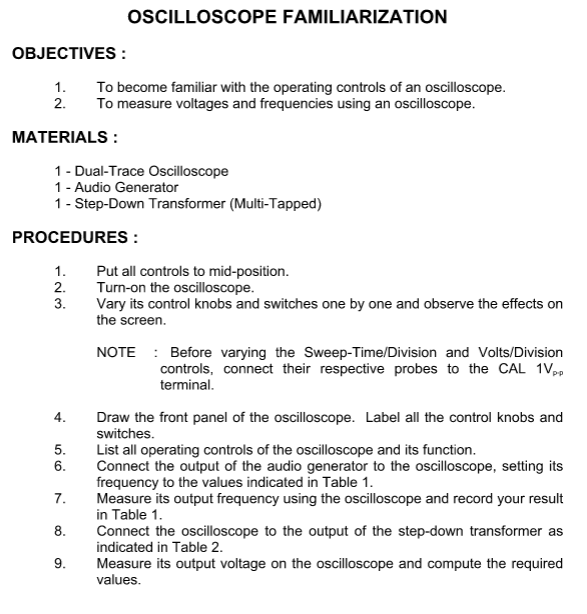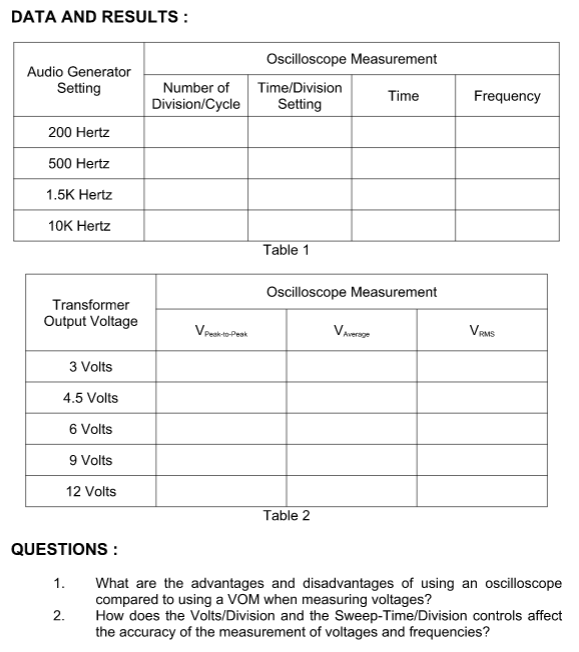What are the advantages and disadvantages of using an oscilloscope compared to using a VOM when measuring voltages? 2. How does the Volts/Division and the Sweep-Time/Division controls affect the accuracy of the measurement of voltages and frequencies
What are the advantages and disadvantages of using an oscilloscope compared to using a VOM when measuring voltages? 2. How does the Volts/Division and the Sweep-Time/Division controls affect the accuracy of the measurement of voltages and frequencies
Introductory Circuit Analysis (13th Edition)
13th Edition
ISBN:9780133923605
Author:Robert L. Boylestad
Publisher:Robert L. Boylestad
Chapter1: Introduction
Section: Chapter Questions
Problem 1P: Visit your local library (at school or home) and describe the extent to which it provides literature...
Related questions
Question
OBJECTIVES :
1. To become familiar with the operating controls of an oscilloscope.
2. To measure voltages and frequencies using an oscilloscope.
QUESTIONS :
1. What are the advantages and disadvantages of using an oscilloscope
compared to using a VOM when measuring voltages?
2. How does the Volts/Division and the Sweep-Time/Division controls affect
the accuracy of the measurement of voltages and frequencies?

Transcribed Image Text:OSCILLOSCOPE FAMILIARIZATION
OBJECTIVES :
1.
To become familiar with the operating controls of an oscilloscope.
To measure voltages and frequencies using an oscilloscope.
2.
MATERIALS :
1- Dual-Trace Oscilloscope
1- Audio Generator
1- Step-Down Transformer (Multi-Tapped)
PROCEDURES :
Put all controls to mid-position.
Turn-on the oscilloscope.
Vary its control knobs and switches one by one and observe the effects on
the screen.
1.
2.
3.
NOTE : Before varying the Sweep-Time/Division and Volts/Division
controls, connect their respective probes to the CAL 1V,
terminal.
4.
Draw the front panel of the oscilloscope. Label all the control knobs and
switches.
5.
6.
List all operating controls of the oscilloscope and its function.
Connect the output of the audio generator to the oscilloscope, setting its
frequency to the values indicated in Table 1.
Measure its output frequency using the oscilloscope and record your result
in Table 1.
8.
7.
Connect the oscilloscope to the output of the step-down transformer as
indicated in Table 2.
9.
Measure its output voltage on the oscilloscope and compute the required
values.

Transcribed Image Text:DATA AND RESULTS :
Oscilloscope Measurement
Audio Generator
Setting
Number of
Time/Division
Time
Frequency
Division/Cycle
Setting
200 Hertz
500 Hertz
1.5K Hertz
10K Hertz
Table 1
Ocilloscope Measurement
Transformer
Output Voltage
Vpeskt Pesk
Vage
3 Volts
4.5 Volts
6 Volts
9 Volts
12 Volts
Table 2
QUESTIONS :
What are the advantages and disadvantages of using an oscilloscope
compared to using a VOM when measuring voltages?
1.
2.
How does the Volts/Division and the Sweep-Time/Division controls affect
the accuracy of the measurement of voltages and frequencies?
Expert Solution
This question has been solved!
Explore an expertly crafted, step-by-step solution for a thorough understanding of key concepts.
Step by step
Solved in 2 steps

Knowledge Booster
Learn more about
Need a deep-dive on the concept behind this application? Look no further. Learn more about this topic, electrical-engineering and related others by exploring similar questions and additional content below.Recommended textbooks for you

Introductory Circuit Analysis (13th Edition)
Electrical Engineering
ISBN:
9780133923605
Author:
Robert L. Boylestad
Publisher:
PEARSON

Delmar's Standard Textbook Of Electricity
Electrical Engineering
ISBN:
9781337900348
Author:
Stephen L. Herman
Publisher:
Cengage Learning

Programmable Logic Controllers
Electrical Engineering
ISBN:
9780073373843
Author:
Frank D. Petruzella
Publisher:
McGraw-Hill Education

Introductory Circuit Analysis (13th Edition)
Electrical Engineering
ISBN:
9780133923605
Author:
Robert L. Boylestad
Publisher:
PEARSON

Delmar's Standard Textbook Of Electricity
Electrical Engineering
ISBN:
9781337900348
Author:
Stephen L. Herman
Publisher:
Cengage Learning

Programmable Logic Controllers
Electrical Engineering
ISBN:
9780073373843
Author:
Frank D. Petruzella
Publisher:
McGraw-Hill Education

Fundamentals of Electric Circuits
Electrical Engineering
ISBN:
9780078028229
Author:
Charles K Alexander, Matthew Sadiku
Publisher:
McGraw-Hill Education

Electric Circuits. (11th Edition)
Electrical Engineering
ISBN:
9780134746968
Author:
James W. Nilsson, Susan Riedel
Publisher:
PEARSON

Engineering Electromagnetics
Electrical Engineering
ISBN:
9780078028151
Author:
Hayt, William H. (william Hart), Jr, BUCK, John A.
Publisher:
Mcgraw-hill Education,